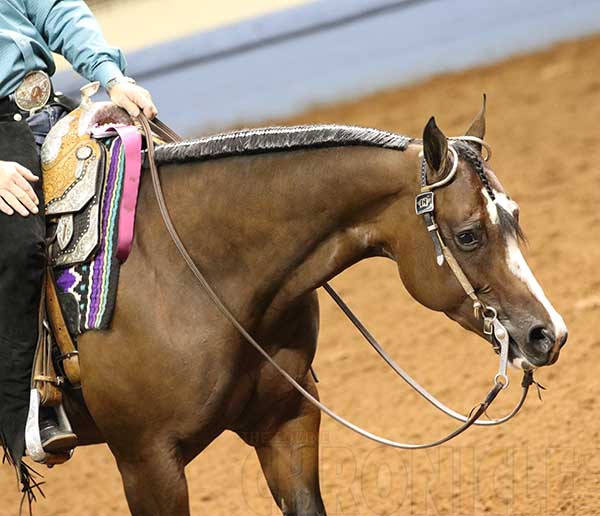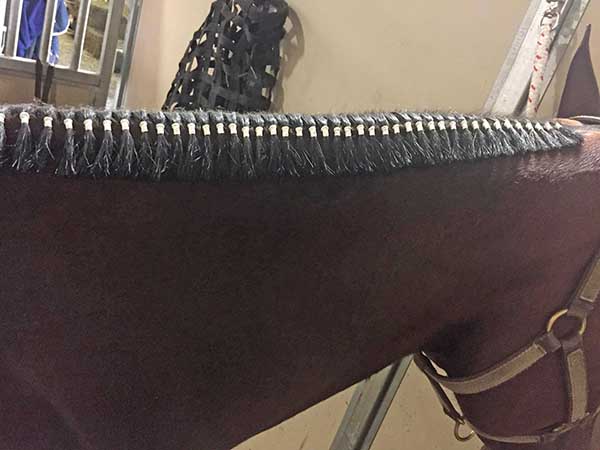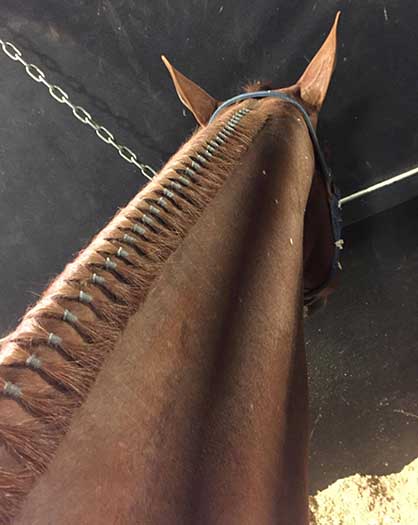Band Color Preference- Coordinating or Contrasting?
By: Brittany Bevis
Band color may seem like such a small detail in the overall picture that it can easily be overlooked. However, there are definite preferences, and opinions differ when it comes to choosing coordinating versus contrasting color bands.
While contrasting bands (white bands in a dark mane) may highlight a horse with a trim neck, coordinating bands (dark bands in a dark mane) help create a uniform picture. Then, there are considerations that must be made with a horse that has a dual or tri-colored mane. Should the band color switch at the color change or stay consistent throughout?
For the answers to these questions and more, see what our The Equine Chronicle readers had to say. If you’d like the chance to contribute to an upcoming article, become a fan of The Equine Chronicle on Facebook.
Michelle Axmaker– “I love the look of white bands on a horse with a great neck, especially a chestnut. I feel it looks even nicer on horses with a lot of chrome, like a big blaze, or an Appaloosa with a blanket pattern. I think white bands on darker horses can really make your Showmanship horse pop!”
“Those contrasting bands show confidence in a super straight horse, but they can also ‘tell on you’ if you make a mistake. In a show pen full of bling, why not let the horse get a little ‘bling’ too? I also like colored yarn on braided horses at the smaller shows, but you have to stay serious and stick with the traditional Hunt Seat braids at the majors.”
Shane Young– “I prefer using matching bands, just so it keeps the picture quiet through their head and neck. I want the look to be as clean and smooth as possible, whether they have still neck or a busy neck. I like it to be very aesthetically pleasing, so when I’m judging I want to be able to see the whole picture, without it being in contrast with itself.”
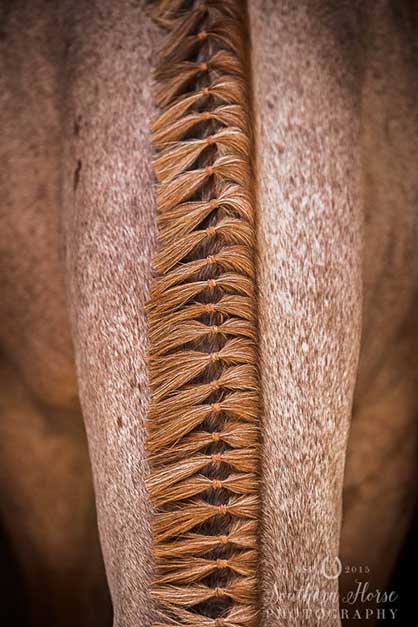
Red bands coordinate with this red roan colored horse. Photo courtesy of Southern Horse Photography.
Clare Swanson– “I think it totally depends on the amount of white on the horse’s body and the quality of their neck/mane. I do prefer the contrast, if the horse can pull it off. I think it adds a flashy presence to the overall look. When it comes to multiple mane colors on a horse, I prefer to keep the whole mane uniform in band color. Switching band colors throughout the mane can make it look choppy. For contrasting bands in manes, it can be a tool to help highlight the ideal neck. In comparison, coordinating bands can help make a neck look better by giving it a cleaner look, for those with a less than ideal neck.”
Shannon Fisher– “When it comes to matching colors, I’m very much a matchy match kind of girl. Depending on the horse, my work can really last. I’ve had horses at the Congress keep their bands the whole show and still be show ring ready, but those horses that rub can be a real nightmare with white bands! White bands on a colored mane do have their place. If the horse has a great topline and a good mane, the end result is gorgeous. But, just keep in mind, if you want white bands, they are going to require upkeep. They do show dirt much more, and I just don’t think they are as strong as the brown and black bands. Horse hair is just like ours; some of them just don’t have good hair, and contrasting bands can show every flaw. But, on the flip side, matching bands will do exactly that: camouflage your imperfections! For horses that are big hocked, and not as strong through their necks, I strongly recommend matching colors.”
“On multi-colored manes, if it’s a significant color change, then yes I alternate the colors. I think it makes for a complete look on a horse with that much color already. I use brown bands a lot. The trick with browns bands is buying the right ones. I hate the ones that are so red they turn pink when you use them. I personally go through and pick out the brown or chocolate brown ones, and those work out great. I also use black bands on my red horses, if they have a dark enough mane. I use black bands on my horse ‘Twiggy’ all the time and it looks fabulous!”
Carly Forest– “I prefer coordinating band colors; because, for most horses, it makes for a cleaner look. Contrasting bands sometime feel distracting and, if the horse doesn’t have a steady topline, can detract from the performance. Now, if the horse has a stellar topline, I think it’s appropriate to draw attention to it using contrasting bands.”
“I definitely think that contrasting bands can highlight a good topline and trim neck, since they draw attention to the neck. Coordinating colors might not camouflage a less ideal neck, but they don’t draw any extra attention to it.”
Brynne Bassler– “I prefer the coordinating bands with the mane color. The only exception is if the horse’s topline is very solid and it has a great neck. Then, I think the white bands help catch your eye and can look exceptional, in that case. You do, however, need a very good band job for the white bands, in my opinion. An average white band job can stick out and not always in a good way!”
“I also like to use the same color throughout the mane to keep a standard professional look. Brown bands are used on my horses for the lighter brown manes; but, if the horse is a chestnut with a darker mane, then I prefer the black bands to keep the job looking nice for longer.”
Liz Barnard Long– “I like coordinating band color, unless the horse has a great topline, then I like white bands. I also like white bands if the horse is plain and needs a little flash. I think, if you use contrasting bands on a horse that has a bad topline, it will accentuate the motion of the neck, so it’s not a good idea.”
Annie Lord- “Call me old fashioned; but, in my barn, black manes get black bands, white manes get white bands, and brown manes get brown bands. I like to keep my bands neat, clean, and without distraction. The look of a contrasting color draws away from the overall appearance of your horse. I like to keep it simple.”
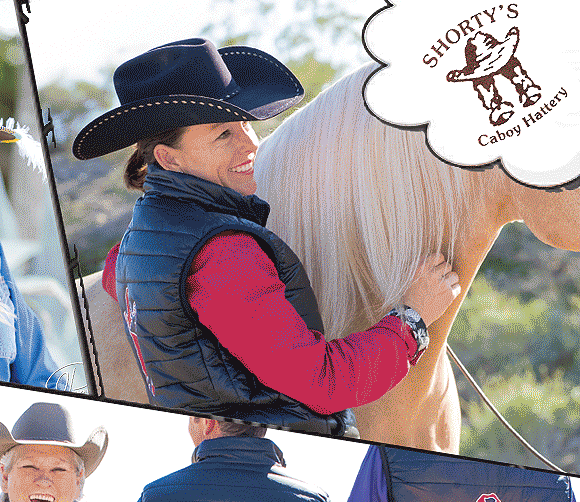 “I prefer the look of one color used throughout. I stick with the predominant mane color. If the mane is more than half black, I use black bands. If it’s more than half white, I use white bands, and so on. On a dual colored horse, I think using one color helps pull the mane together and even out the color down the horse’s neck. I think contrasting bands can actually cause more of a distraction, even on an exceptional horse. A good horse is a good horse, regardless of how it’s banded, but first impressions are important in the pen. If you have a horse that bobs at all in the lope, contrasting bands will only accentuate the head bob, because that’s where your eye is drawn. In the Halter classes, coordinating bands paint a cleaner line and do not distract your eye from the overall presentation.”
“I prefer the look of one color used throughout. I stick with the predominant mane color. If the mane is more than half black, I use black bands. If it’s more than half white, I use white bands, and so on. On a dual colored horse, I think using one color helps pull the mane together and even out the color down the horse’s neck. I think contrasting bands can actually cause more of a distraction, even on an exceptional horse. A good horse is a good horse, regardless of how it’s banded, but first impressions are important in the pen. If you have a horse that bobs at all in the lope, contrasting bands will only accentuate the head bob, because that’s where your eye is drawn. In the Halter classes, coordinating bands paint a cleaner line and do not distract your eye from the overall presentation.”
“Also, the length of the mane plays a key aspect in how your bands will look. Don’t be afraid to play around at home with different techniques. Not all horses look good with 1/4 inch bands. Try 1/2 inch or something in between. If you have time between shows, trim the mane at different intervals to see what length flatters your horse’s neck.”
Joe Engle– “I like black bands on everything… well at least 90 percent of the time. On dual-colored manes, I like a uniformed color with one band color. Normally, I don’t want to draw any extra attention to a horse’s neck, unless they have extreme shape and length. A great bander using dark banding can help and improve a less than ideal neck shape, length, or where it ties in [to the shoulder]. Moreover, the most important thing is your bander! Very few can truly band how I would consider to be great. The top horses at the World Show level are normally very close in quality. We’re looking for just that little edge to win. A top bander can give you that.”
Karen Boxell– “We never use white bands in a dark horse, especially in Western Pleasure, because you see all the neck movement. We do use brown bands in sorrel horses.”
Gracie Cochran– “I personally prefer to see the bands matching the horse’s mane and forelock. I often find it distracting when the bands don’t match. However, if done correctly, it can be very sharp and highlight a nice level head and top line along the rail. With that being said, if the horse moves their neck with every stride or is performing a Horsemanship or Trail maneuver, I believe it can call attention to the wrong places. With a horse that has a dual or tri-colored mane, I think it depends on how much white is in the mane. That’s really a toss up. If you have a chance to highlight the white markings, I think you should do so with white. If there’s a frost throughout the mane, I would also recommend white. I like to see the same color of band throughout the mane, for a nice uniform look.”
“Personally, I have a horse with a roached mane, and I absolutely love the look. My horse has a very wirey and almost striped mane. My mother, being a perfectionist when it comes to grooming, was never satisfied with the results. We found it looked better roached. I show mostly pattern classes on the AQHA circuit with my mare. Her forelock is neatly banded with matching brown bands. People often don’t even notice that she’s roached. From the side, it looks as if her bands are on the opposite side of her neck. I think it’s a very crisp and clean look. It allows me to go from English to Western with just a change of the forelock. Also, it saves us some time!”
Amanda Delgado– “For banding, I really like the coordinating look, but I will put white bands in my Paint chestnut’s mane to really pop the white she has and highlight her pretty neck. I wouldn’t do it on a horse that has a less than ideal neck. I think, if a horse has an awesome neck, the contrasting look can really play up those flattering lines. It has to be a perfect banding job though; otherwise, it makes the horse look off and lumpy!”
“If I had a horse with a multicolored mane, I would definitely skip the contrasting look and go for coordinating. It looks so sharp and clean when exhibitors nail that color change. I saw a horse at the last show with a tri-colored mane that was banded with coordinating colors, and it looked so sharp and clean! I do use brown bands. I would rather see slightly lightened, brown bands than dirty, dingy, white-turned-yellow bands.”
Cassie Rathbun-“I prefer coordinating band color with mane color, because I like the subtle look. I do change the band color because my mare’s mane is black and white.”
Jennifer Harman VanHal– “For me, it depends on the horse itself and the quality of the band job. I would never suggest a novice bander use contrasting colors, as it tends to show every flaw or mistake they may have made. Everyone starts somewhere. If people are just learning to band, coordinating bands might be better for the show pen, until they really get confident in their ability.”
“On my tobiano, I prefer coordinating bands. His mane is ¾ dark brown and ¼ white. I prefer black on dark brown and white on the white. I think, with dual/tri-color manes, you just have to try a few options and then step back and see which one looks the best in the pen. I’ve owned many sorrels and chestnuts, and some have worn white and some have worn dark brown or black. It just depends on the individual’s strengths and weaknesses. I like to use the dark brown, almost black, bands on sorrels. The ones they call ‘brown’ tend to turn orange.”
What’s your band color preference? Weigh in on our The Equine Chronicle Facebook page.










